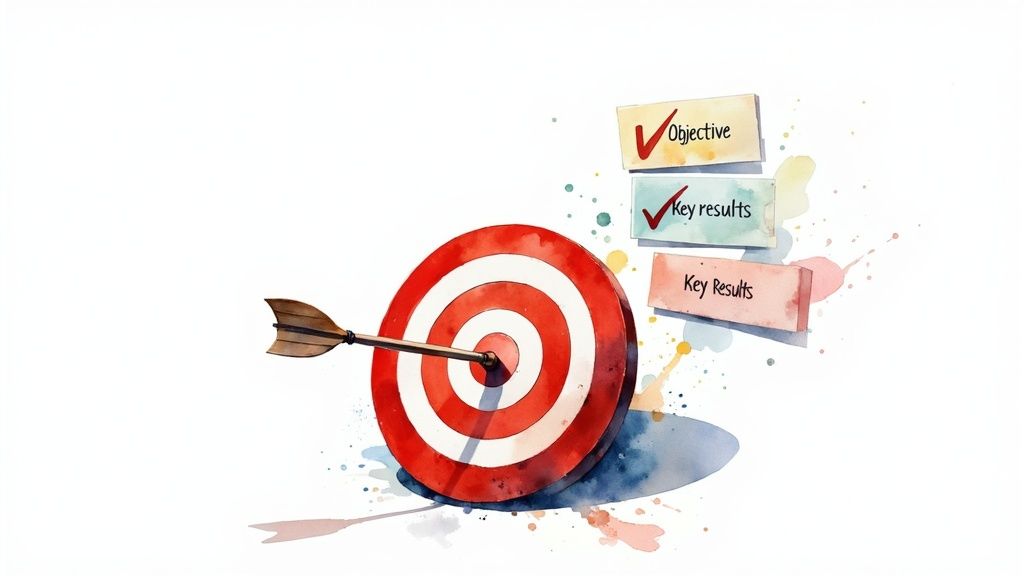10 Proven Ways to Increase Employee Productivity in 2025
Max
In today’s dynamic work environment, especially with the rise of remote and hybrid models, the conversation around productivity has evolved. It’s no longer about simply working harder; it’s about working smarter, fostering engagement, and creating systems that empower every team member to do their best work. This guide cuts through the noise to provide a comprehensive playbook of proven ways to increase employee productivity.
We will explore ten distinct, actionable strategies, moving beyond generic advice to offer concrete frameworks. You’ll find practical steps for implementing everything from flexible work arrangements and objective-based goal setting (OKRs) to meaningful employee recognition programs that resonate. We’ll also cover how to build effective communication systems and leverage the right technology to automate tasks and enhance collaboration without overwhelming your team.
These aren’t just abstract theories; they are practical methods designed to help you build a more efficient, motivated, and successful team. Whether you’re a manager looking to elevate your team’s output, an HR professional shaping company culture, or a team member seeking to improve your own effectiveness, these insights will equip you to drive meaningful results. This article delivers a clear roadmap for boosting performance in any work setting.
1. Flexible Work Arrangements and Remote Work Options
One of the most impactful ways to increase employee productivity is to shift focus from hours clocked to results delivered. Flexible work arrangements, such as remote work, hybrid models, and adjusted hours, empower employees with autonomy over their work environment. This approach acknowledges that productivity isn’t confined to a traditional 9-to-5 office setting, allowing individuals to work when and where they are most effective.

This strategy has been validated by major companies. Microsoft Japan, for example, saw a 40% productivity increase after implementing a four-day workweek. Similarly, companies like GitLab and Automattic have built highly successful, entirely remote workforces, proving that location is not a barrier to high performance. These models often lead to higher job satisfaction, reduced burnout, and a better work-life balance for team members.
How to Implement Flexible Work Models
Successfully transitioning to a flexible model requires a deliberate and structured approach.
- Establish Clear Protocols: Define expectations for communication, availability, and project deliverables. Use shared calendars and status updates to maintain transparency.
- Invest in Technology: Equip your team with the necessary hardware, secure software, and collaboration tools to work efficiently from any location.
- Support Home Offices: Offer stipends for ergonomic setups to ensure employees have a comfortable and productive workspace. For those new to this environment, there are valuable resources like 5 Tips On How To Focus And Be More Productive when working from home that can help ease the transition.
- Foster Culture Virtually: Schedule regular virtual team-building activities, coffee chats, and all-hands meetings to maintain strong team cohesion and a sense of belonging.
2. Goal Setting and Performance Management (OKRs)
A powerful way to increase employee productivity is by implementing a clear and ambitious goal-setting framework. Objectives and Key Results (OKRs) provide a structure for companies, teams, and individuals to set challenging goals with measurable results. This framework creates transparent alignment, ensuring everyone understands how their work contributes directly to the organization’s top priorities, which fosters a sense of purpose and accountability.

This method isn’t just theoretical; it’s a proven strategy used by industry leaders. Google has famously used OKRs since 1999 to drive its exponential growth, a practice brought to them by John Doerr from Intel, where the framework originated. Similarly, companies like LinkedIn and Spotify use OKRs to coordinate autonomous teams and boost engagement, demonstrating the framework’s effectiveness in various organizational structures.
How to Implement OKRs Effectively
Adopting OKRs requires a disciplined approach to ensure they drive performance rather than become another administrative task.
- Be Specific and Ambitious: Limit yourself to 3-5 high-level objectives per cycle. Each objective should have 3-4 specific, measurable, and time-bound key results. Aim for a 70% achievement rate, as this indicates the goals were sufficiently challenging.
- Decouple from Compensation: Separate OKR discussions from formal performance reviews. This encourages teams to take calculated risks and set stretch goals without fear of financial penalty for falling short.
- Ensure Transparency: Make OKRs visible across the entire organization. This transparency promotes cross-functional alignment and helps teams understand interdependencies. To explore this further, check out these performance management best practices.
- Review Progress Regularly: Conduct weekly or bi-weekly check-ins to track progress, identify roadblocks, and adjust tactics as needed. Regular reviews keep goals top-of-mind and maintain momentum throughout the quarter.
3. Employee Recognition and Rewards Programs
A powerful strategy to increase employee productivity is creating systematic programs that acknowledge and reward valuable contributions. By making employees feel seen and appreciated, recognition and rewards programs directly boost morale, motivation, and engagement. This approach shifts the focus from simply completing tasks to celebrating achievements and behaviors that align with company values, fostering a culture of excellence and mutual respect.

This principle is effectively demonstrated by industry leaders. Salesforce ties recognition directly to its V2MOM (Vision, Values, Methods, Obstacles, Measures) framework, reinforcing core company principles. Similarly, Google’s peer-nomination awards and simple “kudos” system empower team members to recognize each other, building a stronger, more collaborative environment. These programs reinforce the connection between individual effort and organizational success, leading to higher retention and performance.
How to Implement Recognition Programs
Building an effective recognition program requires thoughtfulness and clear execution.
- Be Timely and Specific: Acknowledge achievements as soon as possible. Clearly state what the employee did well and explain its positive impact on the team or company.
- Offer a Variety of Rewards: Cater to diverse preferences by offering a mix of monetary bonuses, extra paid time off, public praise, or professional development opportunities.
- Ensure Fairness and Transparency: Establish clear, unbiased criteria for rewards. Communicate the process openly to build trust and ensure everyone understands how to earn recognition.
- Empower Managers: Train managers on the importance of frequent, authentic recognition and provide them with tools, like those offered by platforms such as Bonusly, to make it easy and consistent.
- Measure Program Impact: Use employee engagement surveys and performance data to assess the program’s effectiveness and make data-driven adjustments.
4. Professional Development and Continuous Learning
Investing in your team’s growth is a direct investment in your company’s productivity. Professional development and continuous learning programs equip employees with new skills, deepen their expertise, and prepare them for future challenges. This strategy recognizes that as employee capabilities grow, so does their efficiency, innovation, and overall contribution to business goals.

This approach is one of the most effective ways to increase employee productivity and has been championed by industry leaders for decades. Amazon’s Career Choice program, for instance, pays 95% of tuition for employees to learn new skills for in-demand fields, even if it takes them outside the company. Similarly, AT&T committed $1 billion to a massive reskilling initiative to retrain its workforce for the digital age. These programs boost morale, reduce turnover, and create a more capable and adaptable team.
How to Implement Continuous Learning
A successful learning program must be strategic and accessible to be effective.
- Align Training with Goals: Ensure all learning opportunities are directly linked to both the company’s strategic objectives and individual career paths.
- Embrace Microlearning: Offer bite-sized, on-demand training modules that employees can complete quickly and apply immediately to their work. This improves knowledge retention and engagement.
- Foster Internal Expertise: Create mentorship programs and knowledge-sharing sessions where experienced team members can train their peers, building a strong internal support system.
- Leverage Technology: Utilize learning management systems (LMS) and platforms like Coursera for Business to provide scalable, high-quality training across your organization.
5. Effective Communication and Feedback Systems
A cornerstone of a high-performing team is a robust system for communication and feedback. This involves creating structured channels where information flows freely, clearly, and consistently in all directions. By moving beyond ad-hoc conversations to intentional communication practices, organizations can eliminate ambiguity, align efforts, and foster a culture of continuous improvement, which is a key factor in boosting employee productivity.
This approach is championed by highly successful companies. Netflix, for instance, is famous for its culture of radical transparency, where direct and honest feedback is encouraged at all levels to drive performance. Similarly, Bridgewater Associates, guided by Ray Dalio’s principles, uses radical transparency to ensure that decisions are made based on the best ideas, not hierarchy. These practices create an environment where issues are surfaced and resolved quickly, preventing small misunderstandings from becoming major productivity roadblocks.
How to Implement Strong Communication Systems
Building a culture of clear communication and constructive feedback requires deliberate effort and the right tools.
- Establish a Regular Cadence: Schedule recurring check-ins, one-on-ones, and team meetings to ensure consistent touchpoints for updates and feedback.
- Train Managers and Staff: Equip leaders and team members with the skills to give and receive constructive feedback effectively. Resources on how to ask for feedback at work can provide valuable guidance for employees.
- Utilize Multiple Channels: Leverage tools like Slack for quick updates, Microsoft Teams for collaboration, and email for formal announcements to suit different communication needs.
- Create Psychological Safety: Foster an environment where employees feel safe to voice concerns, share ideas, and provide honest feedback without fear of negative repercussions.
- Act on Feedback: Demonstrate that feedback is valued by taking action on suggestions and communicating the changes made. This reinforces trust and encourages ongoing participation.
6. Workplace Environment and Wellness Programs
A positive and supportive work environment is a cornerstone of high-performing teams, making it one of the most crucial ways to increase employee productivity. This extends beyond physical office space to encompass mental, emotional, and physical well-being. By investing in comprehensive wellness programs, companies demonstrate a commitment to their employees as whole individuals, which in turn fosters loyalty, reduces absenteeism, and boosts engagement.
Leading companies have proven the ROI of this approach. Google is famous for its campus amenities like healthy meals and nap pods, while Johnson & Johnson’s extensive wellness program has saved the company over $250 million in healthcare costs. Salesforce, under Marc Benioff, integrated mindfulness and meditation into its culture to combat stress and improve focus. These initiatives create a culture where employees feel valued and supported, enabling them to perform at their best.
How to Implement Wellness Initiatives
Building a culture of wellness requires a thoughtful and strategic approach that addresses diverse employee needs.
- Gather Employee Feedback: Conduct anonymous surveys to understand what wellness benefits your team values most, whether it’s mental health support, fitness stipends, or financial wellness workshops.
- Prioritize Mental Health: Offer access to counseling services through an Employee Assistance Program (EAP) or subscriptions to mental health apps like Headspace or Calm.
- Encourage Physical Well-being: Promote movement through walking meetings, team fitness challenges, or partnerships with local gyms. For remote staff, this includes encouraging an ergonomic setup. You can find excellent advice on how to set up your home office for success on remotefirstjobs.com.
- Measure and Adapt: Track program engagement and gather feedback to continuously refine your offerings and maximize their impact on employee well-being and productivity.
7. Technology and Automation Tools
One of the most effective ways to increase employee productivity is by strategically implementing technology and automation. This approach focuses on using software to handle repetitive, time-consuming tasks, freeing up employees to concentrate on high-value activities that require critical thinking, creativity, and strategic planning. By automating workflows, you eliminate manual effort and reduce the potential for human error.
This strategy is proven across industries. Zapier connects over 3,000 apps to automate workflows, saving countless hours on data entry. Similarly, Salesforce’s CRM has been shown to increase sales team productivity by over 30% by streamlining customer management. These tools enhance efficiency, allowing teams to accomplish more with less manual intervention and ultimately drive better business results.
How to Implement Technology and Automation
Integrating new tools effectively requires careful planning and execution to maximize their impact.
- Identify Bottlenecks: Start by pinpointing the most time-consuming and repetitive tasks within your team’s workflow. These are prime candidates for automation.
- Choose Integrated Solutions: Select user-friendly tools that integrate seamlessly with your existing systems to avoid creating data silos. Cutting-edge solutions like leveraging advanced capabilities in AI document processing can significantly reduce manual data handling.
- Provide Comprehensive Training: Ensure every team member receives thorough training and ongoing support to feel confident using new platforms.
- Involve Your Team: Include employees in the selection process. Their firsthand experience with daily tasks makes their input invaluable for choosing the most effective tools.
8. Team Building and Collaboration Enhancement
A disconnected team is an unproductive one. Deliberately strengthening team dynamics and improving collaboration are crucial ways to increase employee productivity, as this builds the trust and psychological safety needed for innovation. This approach focuses on creating a cohesive unit where collective intelligence and diverse perspectives are leveraged to solve complex problems and drive results.
Strong team cohesion directly translates to higher engagement, better communication, and reduced friction in workflows. Companies like Pixar are famous for their collaborative creative process, which involves intense cross-departmental feedback to refine ideas. Similarly, Southwest Airlines has built its entire brand on a team-oriented culture that empowers employees, leading to legendary customer service and operational efficiency. When teams feel connected, they are more motivated to work together towards shared objectives.
How to Enhance Team Collaboration
Building a high-performing, collaborative team requires intentional effort and the right systems in place.
- Create Shared Goals: Establish clear, compelling objectives that necessitate collaborative effort from everyone on the team. This ensures that individual contributions are aligned with a collective purpose.
- Facilitate Regular Retrospectives: Schedule recurring sessions for the team to reflect on what’s working, what isn’t, and how to improve processes. This fosters a culture of continuous improvement and shared ownership.
- Invest in Collaborative Technology: Equip your team with the right tools to communicate and work together seamlessly, regardless of location. You can explore a variety of options by learning more about the best remote collaboration tools on remotefirstjobs.com.
- Encourage Cross-Functional Projects: Assign tasks that require input from different departments or skill sets. This breaks down silos, promotes knowledge sharing, and helps employees appreciate the value of their colleagues’ expertise.
9. Time Management and Priority Setting Techniques
One of the most effective ways to increase employee productivity is to equip them with systematic methods for managing their time and prioritizing tasks. Frameworks like the Pomodoro Technique, Getting Things Done (GTD), and the Eisenhower Matrix provide a structured approach to work. These techniques help employees shift from being reactive to proactive, ensuring their efforts are focused on high-impact activities rather than just urgent distractions.
The principles behind these methods are widely adopted in the professional world. Microsoft incorporates “focus time” features into Outlook and Teams, inspired by concepts like Cal Newport’s “deep work.” Similarly, David Allen’s GTD methodology is used by millions to manage overwhelming workloads. By promoting these techniques, companies empower individuals to gain control over their day, which significantly reduces stress and enhances output.
How to Implement Time Management Techniques
Introducing these frameworks requires guidance and consistent practice to see tangible results.
- Introduce Proven Frameworks: Offer training on different methods. The Pomodoro Technique uses 25-minute focused work sprints, while the Eisenhower Matrix helps differentiate between urgent and important tasks.
- Encourage Calendar Blocking: Coach employees to schedule dedicated blocks of “deep work” for complex, high-value tasks. Protect this time from meetings and interruptions.
- Leverage Technology: Promote tools like Trello, Asana, or simple calendar features that support task prioritization and time tracking.
- Promote Regular Reviews: Encourage weekly or daily planning sessions where employees can review priorities, adjust their schedules, and apply principles like the ‘two-minute rule’ for small tasks. For a deeper dive, explore these additional strategies on how to improve time management skills.
10. Empowerment and Autonomy in Decision-Making
Empowering employees with autonomy in decision-making is a powerful method for boosting productivity and innovation. This approach shifts away from top-down micromanagement, giving team members the authority and freedom to make choices within their roles. When employees have ownership over their work and its outcomes, they become more engaged, accountable, and proactive in finding solutions.
This strategy is a cornerstone for many high-performing companies. Netflix champions a culture of “freedom and responsibility,” trusting employees to make impactful decisions without layers of approval. Similarly, W.L. Gore & Associates uses a non-hierarchical “lattice” structure where associates self-commit to projects, driving innovation from the ground up. This level of trust not only accelerates processes but also significantly boosts job satisfaction and retention, making it one of the most effective ways to increase employee productivity.
How to Foster Empowerment and Autonomy
Implementing a culture of autonomy requires building a foundation of trust and providing clear guidance.
- Define Decision-Making Boundaries: Clearly communicate the scope of an employee’s authority. Establish frameworks and criteria so they understand which decisions they can make independently and which require collaboration.
- Start Small and Scale: Begin by delegating smaller decisions and gradually increase the level of autonomy as trust and competence grow. This builds confidence for both the employee and management.
- Provide Necessary Training: Equip your team with skills in critical thinking, risk assessment, and business acumen. The more they understand the business context, the better their decisions will be.
- Create a Safe-to-Fail Environment: Encourage calculated risks and treat mistakes as learning opportunities. Celebrate intelligent failures that provide valuable insights, and establish feedback loops to discuss the outcomes of both good and poor decisions.
Employee Productivity Strategies Comparison
| Strategy | Implementation Complexity 🔄 | Resource Requirements ⚡ | Expected Outcomes 📊 | Ideal Use Cases 💡 | Key Advantages ⭐ |
|---|---|---|---|---|---|
| Flexible Work Arrangements and Remote Work Options | Medium: Requires technology setup and management | Moderate: Investment in tools and security | Increased productivity, employee satisfaction, retention | Companies seeking flexibility and talent reach | Enhanced work-life balance, cost savings |
| Goal Setting and Performance Management (OKRs) | Medium-High: Needs regular cycles and monitoring | Low-Moderate: Time for planning and reviews | Clear alignment, accountability, ambition | Organizations aiming for goal transparency and focus | Drives innovation, improves prioritization |
| Employee Recognition and Rewards Programs | Low-Medium: Program design and administration | Low-Moderate: Rewards and platform costs | Higher motivation, engagement, morale | Companies wanting to boost culture and retention | Cost-effective morale booster, reinforces values |
| Professional Development and Continuous Learning | Medium-High: Structured programs and tracking | High: Training, tuition, mentoring costs | Improved skills, innovation, retention | Organizations investing in long-term employee growth | Enhances capabilities, supports career growth |
| Effective Communication and Feedback Systems | Medium: Requires regular practices and culture shift | Low-Moderate: Time and training investment | Better engagement, faster problem resolution | Teams needing transparency and collaboration | Reduces errors, builds trust |
| Workplace Environment and Wellness Programs | Medium-High: Program and facility setup | High: Investment in wellness resources | Enhanced wellbeing, lower absenteeism | Companies focusing on employee health and retention | Improves morale and reduces healthcare costs |
| Technology and Automation Tools | High: Implementation and integration challenges | High: Initial investment and training | Time savings, accuracy, scalability | Businesses seeking efficiency and data-driven ops | Automates tasks, boosts productivity |
| Team Building and Collaboration Enhancement | Medium: Activities and ongoing facilitation | Moderate: Event and tool costs | Stronger teams, better problem-solving | Organizations emphasizing teamwork and innovation | Builds trust and creativity |
| Time Management and Priority Setting Techniques | Low-Medium: Adoption and behavior change | Low: Minimal tools and training | Improved focus, reduced stress | Individuals and teams needing productivity boosts | Enhances focus and work-life balance |
| Empowerment and Autonomy in Decision-Making | Medium-High: Cultural shift and guidelines | Low-Moderate: Training and support | Faster decisions, higher engagement | Companies promoting innovation and leadership | Increases ownership and innovation |
Putting It All Together: Building a Productive Future
Navigating the landscape of modern work requires more than just incremental adjustments; it demands a fundamental rethinking of how we support and empower our teams. The journey to unlocking peak performance is not about finding a single, one-size-fits-all solution. Instead, it’s about strategically weaving together a tapestry of initiatives that create a holistic, high-performance ecosystem. The ten strategies we’ve explored serve as the essential threads in this design, each one reinforcing the others to build a resilient and motivated workforce.
From the foundational trust granted through flexible work arrangements and employee autonomy, to the clarity provided by robust goal-setting frameworks like OKRs, these elements work in concert. They create an environment where employees feel valued and understand their direct impact on the organization’s success. This sense of purpose is further amplified by meaningful recognition programs and a genuine commitment to professional development, signaling that the company invests in its people’s growth.
Turning Insights into Action
The key to successfully implementing these ways to increase employee productivity lies in a deliberate and people-centric approach. Rather than attempting a complete overhaul overnight, focus on incremental, high-impact changes.
- Start with a Diagnosis: Before prescribing a solution, understand your team’s specific pain points. Use anonymous surveys or one-on-one conversations to identify the most significant barriers to productivity. Is it communication bottlenecks, outdated technology, or a lack of clarity around priorities?
- Launch a Pilot Program: Select one or two strategies that directly address your findings. For instance, if feedback is a major issue, implement a structured system for regular check-ins. If burnout is rising, introduce a wellness initiative or enforce clearer boundaries around working hours. Measure the results and gather feedback before a wider rollout.
- Embrace the Interconnectedness: Recognize that these pillars are not isolated. Implementing new automation tools (Strategy #7) will only succeed if paired with effective communication (Strategy #5) and training. Granting autonomy (Strategy #10) is most effective when supported by clear goals (Strategy #2). A successful productivity strategy is an integrated one.
Ultimately, building a productive future is an ongoing commitment, not a one-time project. It’s about fostering a culture where efficiency and well-being are two sides of the same coin. By championing these principles, organizations not only achieve superior business outcomes but also become magnets for the kind of ambitious, forward-thinking talent that will define the next era of work. The investment you make in creating this environment is the most powerful driver of sustainable growth and innovation.
Whether you are a company seeking to attract top-tier professionals who thrive in productive environments or a talented individual looking for a role that values autonomy and growth, the right connection is crucial. Explore opportunities with forward-thinking companies or find exceptional candidates on Remote First Jobs. Visit Remote First Jobs to discover your place in the future of work.


